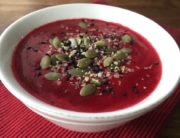Here I’m using the word ‘pimp’ in it’s meaning of making something more showy or impressive. It’s no secret that we eat with our eyes, so why not make healthy food look as stunning as the cakes and treats that entice us with their decorative beauty. And if that embellishment ramps up the overall nutrition content of the meal then it’s a winning situation.
The nutrition bling described here are all powerhouses of nutrients, each with their own specific highlights outlined below, and all are store cupboard ingredients that you can keep on hand. You can also use whatever fresh ingredients you have at the time too – some of my favourites are pomegranate seeds, passionfruit, berries, lemon or lime zest.
6 reasons to embrace nutrition bling:
1. Visual appeal stimulates the digestive process
The first stage of digestion is known as the cephalic phase. This is when we use our senses to interact with the food in front of us, signalling to the brain that food is coming and to prepare the body with the necessary digestive juices. Giving y our food a makeover certainly elicits a stronger cephalic response.
2. Bling makes you chew more
Chewing stimulates gastric juices and allows the food to interact with the enzymes in saliva making the digestive process more efficient. Smooth liquid foods like smoothies and soups can be swallowed with little interaction in the mouth. Adding some bling encourages chewing, so you’ll absorb more nutrients from your meal and have fewer digestive symptoms as a result.
3. Boosting and balancing protein
If you feel your meal is lacking in protein you can use selective bling to address this. Nuts, seeds, bee pollen and goji berries are all good sources of protein if you need a little extra. If you get your protein from vegan sources you could be missing some essential amino acids. For example, a soup using beans, legumes or lentils as the protein source will be lacking in the amino acid methionine. Seeds are high in methionine so you can use seeds to balance this and ensure you get the full range of essential amino acids.
4. Bling for more healthy fats
The extra fats make the meal more satiating and will keep you feeling full for longer. Without fats we don’t absorb all the fat-soluble vitamins and antioxidants in our food. Adding some chopped nuts or seeds can help us get the most benefit from all the other ingredients we have used. If there are certain fats you need more if, such as anti-inflammatory omega-3 then you can use bling rich in omega-3 like flaxseed and chia seed.
5. Strategic bling to address mineral or vitamin deficiencies
If there are certain minerals or vitamins you need more of you can select the bling with the highest amounts of those nutrients and add them to your meals to correct deficiencies.
6. Colourful bling adds more phytonutrients
Using contrasting colours not only gives more visual appeal, but also helps increase the spectrum of phytonutrients derived from colour pigments in foods. You can read more on nature’s pigments here to see how specific colour pigments support health.
To use your nutrition bling in the most strategic way it helps to know what each item is best for. Here’s a run down of their best features to help you decide:
Flaxseeds
These seeds are a great source of alpha-linolenic acid, an anti-inflammatory omega-3 fat. They contain a decent amount of protein and also a good amount of fibre, both soluble and insoluble.
The mucilage gums in flaxseeds – arabinoxylans and galactoxylans – slow down the movement of food from the stomach making you feel full for longer and as they slow down the passing of food in the small intestines this allows more nutrients to be absorbed. These mucilaginous fibres also support a healthy digestive tract, regulating bowel movements and calming irritable bowel symptoms. The fibres also help reduce cholesterol by binding bile salts in the gut for excretion. As cholesterol is needed to make bile salts, the removal of bile salts from the body in this way lowers circulating cholesterol levels.
Flaxseeds are the best source of lignans, having seven times more than the closest runner up, sesame seeds. Lignans are polyphenols found in plants that act as antioxidants, but also when consumed are converted by bacteria in the gut into enterodiol and enterolactone which have weak oestrogenic activity. This makes them act as phytoestrogens – substances that can exert an oestrogen effect in those with low levels such as postmenopausal women and also reduce the effect of excess oestrogen by binding to oestrogen receptors in cells with these weaker versions displacing more potent oestrogens such as those from plastics. This helps out with problems relating to oestrogen dominance and reduces risk of oestrogen-driven cancers such as breast and prostate. To get these effects healthy gut bacteria are also needed.
Sesame seeds
These tiny seeds have a very high phytosterol content, which helps to balance cholesterol levels by reducing LDL cholesterol. Sunflower seeds and pumpkin seeds also have decent amounts of phytosterols too should you want to blend your bling for this purpose. Sesame is also a good source of arginine, an amino acid that supports heart health.
As the second highest source of lignans after flaxseeds, they have the same oestrogen balancing benefits and they also contain unique lignans called sesamin and sesamol, which protect the liver against oxidative damage and protect DNA from the mutative effects of radiation.
Sesame seeds are a top source for copper, a common mineral deficiency, which can help with the pain and swelling of rheumatoid arthritis. Copper helps incorporate iron into haemoglobin in red blood cells to carry oxygen around the body, so if you’re anaemic and taking iron doesn’t help, maybe copper is needed. Sesame contains iron as well making them a good option for anaemia.
Copper is also part of the powerful antioxidant enzyme superoxide dismutase (SOD).
A good choice also for anyone worried about osteoporosis as they are great for building strong healthy bone being a rich source of not just calcium but also other important bone minerals like magnesium, phosphorus, manganese and zinc.
Sunflower seeds
A great source of vitamin E, which is a potent fat-soluble antioxidant that neutralises free radicals in fats. Free radicals cause oxidative damage, an underlying issue in many diseases. Vitamin E protects the fats in LDL cholesterol from oxidation, and it’s the oxidised LDL that’s implicated in atherosclerosis – the blockage of arteries leading to heart disease and stroke, so sunflower seeds help reduce that risk. The brain is also mostly fats so vitamin E helps protect that vital organ too.
Sunflower seeds are a good source of many important minerals including copper (whose benefits are explained above), and selenium, which is part of the body’s most powerful antioxidant enzyme – glutathione peroxidase, making it cancer protective and protective against DNA damage. Selenium is also important for the conversion of thyroid hormone into it’s active form.
They also contain magnesium, which is a very common mineral deficiency that relaxes muscles including those lining blood vessels – this makes it helpful to lower high blood pressure, relieve cramps and muscle tension, and also tension headaches. Together with the good amounts of manganese and phosphorus, sunflower seeds help build strong bones.
These seeds are also a good source of thiamin (vitamin B1), which is important for energy production and therefore essential for both heart and brain health as these organs require a lot of energy. Thiamin is also important for a healthy nervous system.
Pumpkin seeds
These seeds are a great source of zinc, which is important for the immune system, for cell growth and division making it helpful for wound healing, important for our sense of taste and smell, important for healthy eyes and healthy skin and beneficial for male health to support both sperm production and prostate health.
Pumpkin seeds contain the most diverse mix of antioxidants including several different forms of vitamin E such as alpha-tocopherol, gamma-tocopherol, delta-tocopherol, alpha-tocomonoenol and gamma-tocomonoenol. That’s a mouthful, but it translates to having all bases covered against the damaging effects of pro-oxidants. So although they aren’t a top source for a single antioxidant, the overall antioxidant capacity of pumpkin seeds is vast. Pumpkin seeds are also rich in manganese which acts as an antioxidant in the skin to protect against UV damage.
Manganese is also important for energy production and keeping calcium in bones. Another mineral, magnesium, is also important for both energy and strong bones. Magnesium also acts as a muscle relaxant helping relieve tension and relaxing the muscles lining the blood vessel walls to reduce hypertension. Together with a good amount of the omega-3 fat – linolenic acid, and the amino acid arginine, this makes pumpkins seeds good for the heart. Arginine is also associated with lower levels of C-reactive protein – an inflammatory marker linked to heart disease.
Pumpkin seeds provide a good amount of protein and are high in the amino acid tryptophan which supports healthy moods and good sleep as it’s converted into serotonin, the happy hormone, and melatonin, the sleep hormone. It also contains an unusual anti-parasitic amino acid called curcurbitin, which acts as an anthelmintic (worm-expelling).
Rich in fibre for healthy bowel function, they keep things moving and the fibre also helps stabilise blood sugar levels by slowing down the release of glucose from the meal. The chlorophyll, which gives pumpkin seeds their green colour, binds to toxins in the gut preventing them being absorbed.
Shelled hemp seeds
The stand-out benefit of hemp seeds are the blend of healthy fats. They have the perfect ratio of omega-3, 6 and 9, with the ideal 3:1 ratio of omega 6 and omega 3 making it great for skin conditions. Hemp is a good source of gamma linolenic acid (GLA), an anti-inflammatory omega-6 fat, also found in evening primrose oil, blackcurrant seed oil and borage seed oil. GLA is beneficial for skin issues including eczema, psoriasis, dermatitis, dry and itchy skin, and also the little bumps common on the upper arms. GLA is also great for PMS symptoms and has a beneficial effect on blood lipids, lowering LDL cholesterol and triglycerides while increasing HDL cholesterol, as well as lowering high blood pressure. There’s more… GLA is also good for weight loss and prevents regaining that weight, so anyone tired of their weight piling back on after all the hard work of losing it could benefit from hemp seeds.
Hemp is a great protein source and is a complete protein, containing all the essential amino acids, with similar levels to red meat by weight. The protein in hemp is in the form of edestin, which makes it very digestible, so ideal for anyone with digestive issues that make it hard to properly digest and absorb proteins from other sources.
It’s a good food to support diabetics and pre-diabetics as being mostly fats and protein, hemp is extremely low carbohydrate, most of which is fibre, and this give hemp seed a glycaemic load of zero, making it great for anyone trying to stabilise blood sugar and lower insulin levels. GLA has also been demonstrated to improve the symptoms of diabetic neuropathy.
Hemp also supports the nervous system with lecithin and inositol. Lecithin is used to produce choline (for nerve impulses) and acetylcholine (for short-term memory). Inositol (vitamin B8) is calming for the nervous system and also supports hair growth. Good levels of minerals such as potassium, calcium and magnesium all help support nerve impulses as well.
Black seed
Also known as nigella saliva, kalonji or black cumin seed, this little seed has been used for centuries for just about every health problem. Mentioned in the Old Testament and also found in King Tutankhamen’s tomb, it has a very long history of medicinal use.
One of the key medicinal constituents is crystalline nigellone, which inhibits the release of histamine making it great to reduce allergy symptoms. It also has an antispasmodic effect and increases clearance of mucous from the lungs, making it helpful for cold symptoms as well as other respiratory diseases like asthma and bronchitis.
Another star constituent is an antioxidant called thymoquinone that is an effective anti-cancer compound that causes cancer cell death. Thymoquinone also protects the liver and kidneys against damage so a great addition for anyone looking for extra support for those organs.
Beneficial for type-2 diabetics, black seed has been shown to reduce fasting blood sugar levels, reduce insulin resistance and increase pancreatic beta-cell function, and all on just 2g per day over a few months.
Black seed also has a good track record in reducing high cholesterol, both total and LDL levels, as well as lowering high triglycerides. That was achieved on 2g per day over 12 weeks.
Another thing this little seed is good for is improving learning and memory and countering the damage of neurodenegeration. This is due to the thymoquinone as well as other compounds like carvacrol and thymol together with flavonoids, all of which support a healthy nervous system. Black seed also acts as an anti-convulsive so can support those with seizures and epilepsy. By increasing levels of GABA it can improve mood and work against anxiety too.
It helps with fatigue by boosting energy and restoring mitochondrial dysfunction, helps support male fertility and protects against the damaging effects of ionising radiation. It is not, however, recommended for those on blood thinning medications or during pregnancy.
Chia seed
Chia is a great source of protein, it is also a complete protein as it contains all the essential amino acids, making it a great addition for those limiting animal proteins.
These seeds are a rich source of anti-inflammatory omega-3 fats as alpha-linolenic acid. They also have a high levels of fibre. In fact, the carbohydrate content of chia seed is almost entirely fibre making it great for weight loss and managing diabetes as it doesn’t increase blood sugar levels so does not trigger insulin. The high protein and healthy fats also make it very satiating, so you’ll stay full for longer.
Chia seed is a great source of antioxidants, especially phenolic acids such as rosmarinic acid and protocatechuic acid which have powerful antioxidant effects, anti-inflammatory effects and are also anti-microbial and neuroprotective. Chia also has good amounts of chlorogenic acid, which helps lower high blood pressure, and quercetin, a powerful flavonoid antioxidant. The free radical scavenging power of chia is a great reason to include these little seeds.
Chia seeds also contain various minerals such as manganese, phosphorus, magnesium, calcium and selenium, making them supportive for strong bones and energy.
Flaked almonds
Almonds are a good source of monounsaturated fats (the same fats found in olive oil) helping them to reduce risk of heart disease. Monounsaturated fats support a healthy heart as well as lower LDL cholesterol and reduction in belly fat. With the monounsaturated fats also comes vitamin E as alpha-tocopherol, which helps protect fats against oxidation, and it’s the oxidised cholesterol that is the problem for heart disease.
Almonds are also a good source of protein and fibre, and together with the healthy fats this makes them helpful for blood sugar control as they slow the rise in blood sugar after meals. They also contain magnesium which helps blood sugar control by increasing insulin sensitivity, and they have good levels of potassium, which together with magnesium, helps reduce high blood pressure.
Almonds are also a good source of biotin which is important for healthy hair, skin and nails, as well as for eye health, nervous system health and for embryonic growth during pregnancy.
Desiccated coconut
This is the shredded dried coconut meat and is rich in minerals and fibre. Coconut flesh contains high amounts of copper and manganese, which both support healthy collagen production and strengthens connective tissue including joints, ligaments, tendons and skin. Copper plays an important role in the production of myelin, the insulation around nerves, and helps the absorption of iron which is needed for haemoglobin to transport oxygen around the body. Manganese is important for energy metabolism, healthy bone and as a component of the important antioxidant enzyme – superoxide dismutase.
Coconut is a good source of medium chain triglycerides including caprylic acid, lauric acid, myristic acid, which are not only good sources of fast energy, but have powerful anti-microbial, anti-viral and anti-fungal properties. Monolaurin which is derived from lauric acid is very effective against viruses.
Coconut is also good for energy due to the presence of vitamin B2 (riboflavin) which supports energy as well as healthy eyes. Good levels of selenium are important for the conversion of thyroid hormone into it’s active form to increase metabolism. Selenium also supports the immune system and protects DNA against damage.
Goji berries
These little berries support longevity and are anti-ageing. They stimulate the production of human growth hormone which keeps us youthful and declines as we age, and that decline is linked to signs of ageing. Human growth hormone also stimulates testosterone, leading to greater sex drive in both men and women. And with the high zinc content, this support sperm quality and motility too.
Goji berries are packed with beta-carotene and zinc making them a great immune system boost. Add in the high levels of the antioxidants lutein and zeaxanthin and you have a great food to support healthy eyes. Goji’s are one of the best food sources of the powerful eye nutrient zeaxanthin.
Goji berries are surprisingly high in protein and contain nineteen different amino acid including all the essential ones. Also, with a good amount of fibre they help support blood sugar stability and insulin sensitivity. Dried fruits are believed to be high in sugars and a problem for managing insulin, but goji berries in fact lower blood sugar levels. This makes them a great snack if you’re diabetic or trying to keep your insulin levels down to manage weight or other insulin-driven issues.
They are a good source of organic germanium, a trace mineral that enhances the immune system and is believed to have cancer-fighting properties. Also considered an adaptogen, goji berries help strengthen the system and support the adrenals to deal with stress more easily.
Cacao nibs
This is chocolate in its least processed and most natural form. It’s one of the best sources of magnesium, making them great for energy, lowering blood pressure, balancing blood sugar and relaxing tense muscles and cramps. They contain potassium which also helps reduce high blood pressure and helps maintain proper levels of hydration.
Cacao has a good amount of chromium, which is important for blood sugar regulation, zinc for many enzymatic reactions, and manganese and iron which are needed for the formation of haemoglobin helping to carry oxygen around the body.
They may have the highest concentration of antioxidants of any food and the polyphenols support good moods. Anandamide, a cannabinoid endorphin that we naturally produce after exercise, also called the ‘bliss chemical’ is found in only this one food.
Cacao contains the methylxanthin – theobromine, a relative of caffeine but without the same stimulant effect. Theobromine dilates blood vessels helping it to lower blood pressure, and the increase in blood flow also helps filter and remove more toxins, gets more oxygen around the body to improve energy, and more blood flow to the brain to help cognitive function. Theobromine also suppresses appetite, and is an antibacterial substance that kills streptococcus mutans, the bacteria that causes tooth decay. It has also been shown to harden the enamel on teeth, so a much safer alternative to fluoride in toothpaste. In it’s raw form cacao is also rich in vitamin C, which also supports microbial defences.
Bee pollen
This is pretty much complete nutrition in one food source, and contains nearly all the nutrients we require. A complete protein with all 22 amino acids present and in the form of free amino acids making it highly assimilable and ready to use. There are 14 different fatty acids including all the essential fats. This makes it supportive for the production of hormones.
It’s a very rich source of vitamins, including lots of B vitamins, nearly all except B12. Vitamin C, D, E and the best source of rutin which strengthens capillaries. There are also carotenes, xanthophylls and lots of minerals including trace minerals like gold.
Bee pollen is used by athletes to improve performance, as it’s good for strength and endurance, and also to help recovery after exercise. It also reduces histamine production making it good for allergies.
Bee pollen is also an aromatase inhibitor which means it can increase levels of testosterone in big doses. This means women should use it in moderation (about a teaspoon a day), as although women need some testosterone for energy and good sex drive, too much can be a problem. For men and athletes this is a good thing.
Summary
So get creative and add some bling to your meal. Use the list above to choose the bling that best supports your needs, but my recommendation is to use variety to benefit from all the wonderful compounds in them all. The information provided is general and for use in moderate amounts. As with all foods eating large amounts can have negative interactions with medications and be contra-indicated with certain conditions. Consult a professional if you have any medical conditions.







Leave A Comment